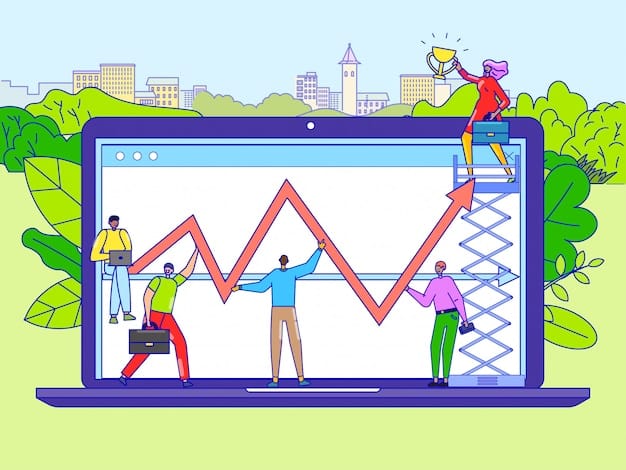Community Event Evaluation: Measure Success & Improve

Community event evaluation involves systematically assessing the effectiveness and impact of events to measure success, identify areas for improvement, and inform future planning and resource allocation, ultimately enhancing community engagement and satisfaction.
Are you hosting community events and wondering if they’re truly making a difference? **Community event evaluation: measure your success and identify areas for improvement** is the key to understanding what works, what doesn’t, and how to make your future events even more impactful. Let’s dive into how to make the most of your events!
Understanding the Importance of Community Event Evaluation
Evaluating community events is crucial for ensuring that they meet their intended goals and provide value to the community. This process helps organizers understand the impact of their events and make informed decisions for future planning.
A well-executed **community event evaluation** can reveal valuable insights into participant satisfaction, program effectiveness, and overall community impact. Let’s explore why this evaluation is so important.
Gauging Event Impact
One of the primary reasons to conduct a **community event evaluation** is to gauge the event’s impact on the community. This involves assessing whether the event achieved its intended outcomes, such as increased community engagement, awareness of a specific issue, or fundraising goals.
Identifying Areas for Improvement
No event is perfect, and a thorough evaluation can highlight areas that need improvement. This includes identifying logistical challenges, program weaknesses, and aspects that participants found unsatisfactory. Addressing these areas can lead to more successful future events.
- Assess participant feedback through surveys and interviews.
- Analyze logistical data, such as attendance and resource utilization.
- Review program outcomes against initial objectives.
By consistently evaluating community events, organizers can continuously refine their strategies and improve the quality of their programs. This iterative process ensures that events remain relevant and beneficial to the community.

Setting Clear Objectives Before the Event
Before diving into the evaluation process, it’s essential to set clear and measurable objectives for your community event. These objectives serve as benchmarks against which the event’s success will be measured.
Defining specific goals upfront helps ensure that the **community event evaluation** is focused and relevant. Let’s explore how to set effective objectives.
Defining SMART Objectives
When setting objectives, it’s helpful to use the SMART framework, which stands for Specific, Measurable, Achievable, Relevant, and Time-bound. This approach ensures that objectives are well-defined and realistic.
Aligning Objectives with Community Needs
Objectives should be aligned with the needs and interests of the community. This requires understanding the community’s priorities and designing events that address those needs. Conducting community surveys and focus groups can provide valuable insights.
- Ensure objectives align with the event’s overall mission and vision.
- Consult with community stakeholders to gather input and ensure relevance.
- Establish Key Performance Indicators (KPIs) to measure progress toward objectives.
Setting clear and relevant objectives is a foundational step in **community event evaluation**. It provides a roadmap for planning, execution, and assessment, ensuring that the event delivers maximum value to the community.
Collecting Feedback: Methods and Tools
Gathering feedback from participants is a critical component of **community event evaluation**. There are various methods and tools available to collect feedback, each with its own strengths and weaknesses. Choosing the right approach can significantly impact the quality and usefulness of the data collected.
Effective feedback collection helps organizers understand what worked well and what needs improvement. Let’s explore some common methods and tools.
Surveys and Questionnaires
Surveys and questionnaires are widely used for collecting structured feedback. They can be administered online or in-person and can include a mix of multiple-choice, rating scale, and open-ended questions. Online survey tools like SurveyMonkey and Google Forms make it easy to create and distribute surveys.
Interviews and Focus Groups
Interviews and focus groups provide opportunities for more in-depth feedback. Interviews can be conducted one-on-one, while focus groups involve a small group of participants. These methods allow for a more nuanced understanding of participants’ experiences and opinions.
- Use a combination of quantitative and qualitative methods for a comprehensive assessment.
- Ensure anonymity and confidentiality to encourage honest feedback.
- Pilot test feedback tools to identify and address any issues before widespread use.
Collecting feedback is essential for understanding the impact of community events and identifying areas for improvement. By using a variety of methods and tools, organizers can gather valuable insights and make informed decisions for future events.
Analyzing Data and Identifying Trends
Once feedback is collected, the next step is to analyze the data and identify trends. This involves organizing and interpreting the data to understand patterns and draw meaningful conclusions.
Effective data analysis is crucial for making informed decisions about future events. Let’s explore some key techniques for analyzing **community event evaluation** data.
Quantitative Analysis
Quantitative analysis involves using statistical techniques to analyze numerical data, such as survey responses and attendance figures. This can include calculating averages, percentages, and correlations to identify trends and patterns. Spreadsheet software like Excel can be used to perform these analyses.
Qualitative Analysis
Qualitative analysis involves interpreting non-numerical data, such as interview transcripts and open-ended survey responses. This can involve identifying common themes, categorizing responses, and drawing inferences based on the data. Qualitative data analysis software can assist with this process.
- Use data visualization techniques to present findings in a clear and accessible format.
- Segment data to identify differences in feedback from different participant groups.
- Compare data from multiple events to track changes over time and identify long-term trends.
Analyzing data and identifying trends is essential for understanding the impact of community events and making informed decisions. By using a combination of quantitative and qualitative techniques, organizers can gain valuable insights and improve the quality of their programs.

Communicating Evaluation Results
Communicating the results of **community event evaluation** is essential for transparency and accountability. Sharing findings with stakeholders, including participants, sponsors, and community leaders, helps build trust and demonstrates a commitment to continuous improvement.
Effective communication ensures that evaluation results are used to inform decision-making and improve future events. Let’s explore how to communicate evaluation results effectively.
Preparing a Summary Report
A summary report provides an overview of the evaluation findings, including key successes, areas for improvement, and recommendations for future events. The report should be clear, concise, and accessible to a broad audience. Key findings should be highlighted with visuals such as charts and graphs.
Sharing Results with Stakeholders
Evaluation results should be shared with all relevant stakeholders, using appropriate channels such as email, presentations, and community meetings. Tailor the message to the specific audience, highlighting the information that is most relevant to them. Encourage feedback and input to ensure that everyone is engaged in the improvement process.
- Use a variety of communication channels to reach different audiences.
- Provide opportunities for stakeholders to ask questions and provide feedback.
- Demonstrate how evaluation results will be used to improve future events.
Communicating evaluation results is essential for building trust, ensuring accountability, and driving continuous improvement. By sharing findings with stakeholders and incorporating their feedback, organizers can ensure that community events are relevant, effective, and beneficial to the community.
Implementing Improvements for Future Events
The ultimate goal of **community event evaluation** is to use the findings to implement improvements for future events. This involves translating the evaluation results into actionable steps and incorporating them into the event planning process.
Effective implementation ensures that events continue to evolve and meet the changing needs of the community. Let’s explore how to implement improvements effectively.
Prioritizing Recommendations
Based on the evaluation findings, prioritize recommendations for improvement. Focus on the areas that will have the greatest impact on event success and participant satisfaction. Consider factors such as feasibility, cost, and time constraints when prioritizing recommendations.
Integrating Improvements into Event Planning
Integrate the prioritized recommendations into the event planning process. This may involve revising event objectives, adjusting program content, improving logistical arrangements, or enhancing communication strategies. Ensure that all members of the event planning team are aware of the changes and their rationale.
- Develop an action plan with specific tasks, timelines, and responsibilities.
- Monitor progress and track the impact of implemented improvements.
- Continuously evaluate and refine event planning processes to ensure ongoing success.
Implementing improvements is essential for ensuring that community events continue to evolve and meet the changing needs of the community. By using evaluation findings to inform the event planning process, organizers can create more impactful, engaging, and successful events.
| Key Point | Brief Description |
|---|---|
| 🎯 Setting Objectives | Define clear, measurable goals using the SMART framework. |
| 📊 Collecting Feedback | Use surveys, interviews, and focus groups to gather participant experiences. |
| 📈 Analyzing Data | Identify trends using quantitative and qualitative analysis. |
| 📣 Communicating Results | Share findings with stakeholders for transparency and accountability. |
Frequently Asked Questions (FAQ)
▼
Evaluating community events helps determine their impact, identify areas for improvement, and ensure they meet community needs and objectives, leading to better future events.
▼
SMART objectives are Specific, Measurable, Achievable, Relevant, and Time-bound. These criteria ensure that objectives are well-defined and realistic, making evaluation more effective.
▼
Common methods include surveys, questionnaires, interviews, and focus groups. Using a mix of these can provide a comprehensive understanding of participant experiences and opinions.
▼
Results should be shared through summary reports, presentations, and community meetings. Tailor the message to each audience and encourage feedback for continuous improvement.
▼
Evaluation findings should be used to prioritize recommendations and integrate improvements into the event planning process, ensuring future events are more impactful and engaging.
Conclusion
In conclusion, **community event evaluation** is a vital process for ensuring that events are successful, beneficial, and aligned with community needs. By setting clear objectives, collecting feedback, analyzing data, communicating results, and implementing improvements, event organizers can create impactful experiences that strengthen community bonds and drive positive change.





